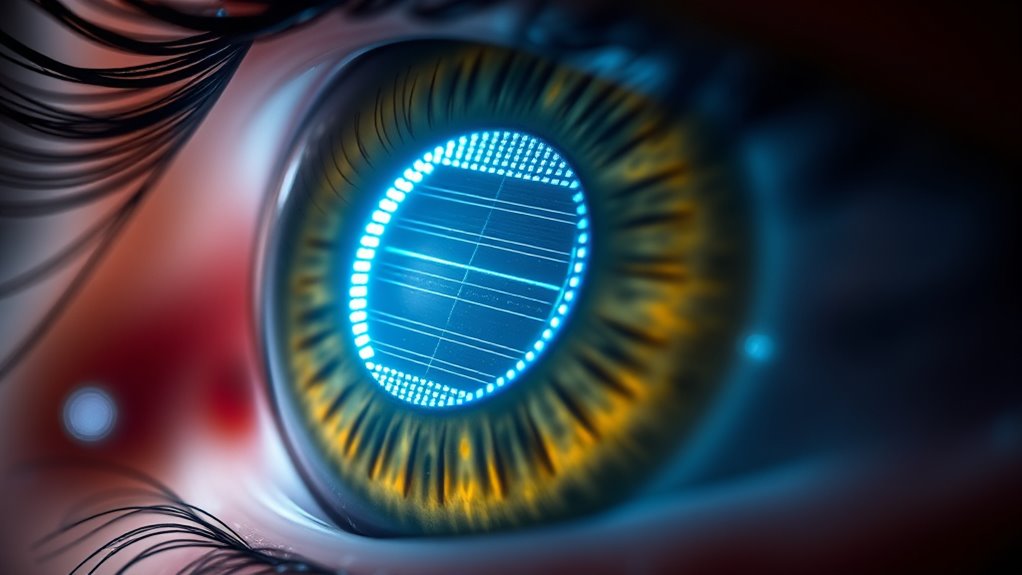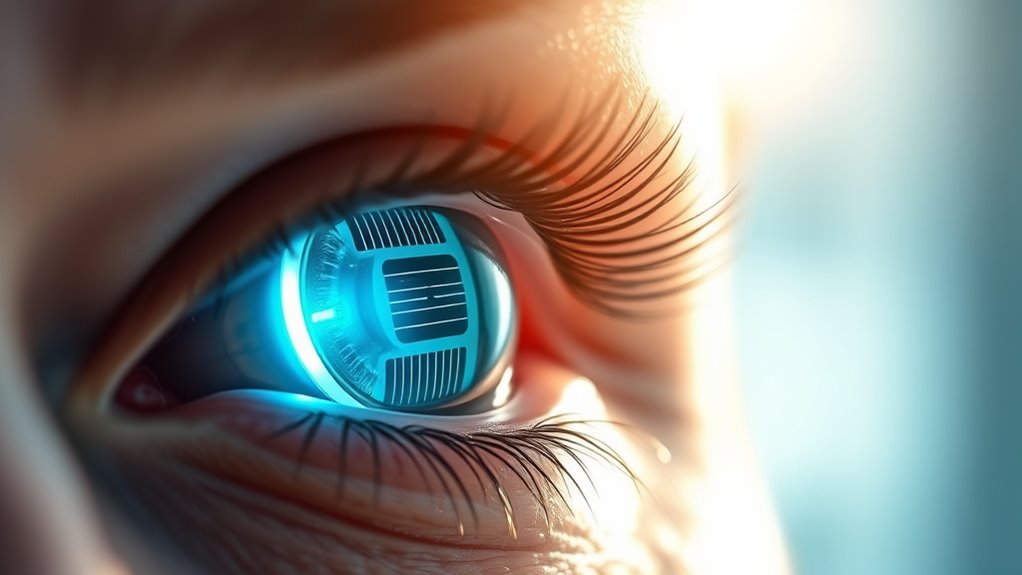A solar-powered eye implant can restore your ability to see clearly by harnessing sunlight with embedded transparent solar cells. It converts sunlight into electrical signals that bypass damaged areas of your retina, sending visual information to your brain. This innovative device is small, minimally invasive, and doesn’t need batteries or external power. It works seamlessly outdoors in changing conditions, offering a natural visual experience. Keep reading to discover how this breakthrough could change your life.
Key Takeaways
- Tiny eye implant uses embedded transparent solar cells to harness sunlight and power visual processing without batteries.
- It restores detailed vision, enabling users to read, recognize faces, and perform fine visual tasks.
- The device is minimally invasive, seamlessly integrating with neural pathways for natural sight restoration.
- Powered solely by sunlight, it adapts to changing light conditions for consistent, stable vision.
- Extensive testing shows significant improvements, offering a sustainable alternative to traditional treatments for macular degeneration.

Imagine a future where missing or damaged eyesight can be restored effortlessly, thanks to a tiny eye implant that harnesses the power of sunlight. This revolutionary device offers new hope for millions suffering from macular degeneration, a leading cause of vision loss. Instead of relying on cumbersome glasses or invasive surgeries, you could simply wear this implant, which seamlessly integrates with your eye and works quietly in the background. Its design is minimally invasive, making recovery faster and reducing the risk of complications. The implant’s core function is to capture sunlight through a tiny, transparent solar cell embedded in the device. As sunlight hits the solar cell, it converts the light into electrical energy, which then powers a microelectronic system within the implant. This system processes visual information and transmits it directly to your brain via existing neural pathways, bypassing the damaged macula.
The beauty of this technology is that it uses natural sunlight as its energy source, eliminating the need for batteries or external power supplies. You can go about your day outdoors, soaking in sunlight without concern, knowing that your eye is continuously generating the power needed to restore clear vision. The system is designed to be highly efficient, ensuring that even on cloudy days, it still receives enough light to function effectively. It adapts dynamically to changing light conditions, maintaining consistent performance. Once in place, the implant provides a stable, clear view of the world, restoring your ability to read, recognize faces, and enjoy detailed visual tasks that macular degeneration would otherwise impair. Additionally, ongoing advancements in neural interface technology promise even more seamless integration with the brain’s visual processing centers.
Because it directly stimulates your visual cortex through natural pathways, the implant offers a more natural and comfortable experience compared to traditional prosthetics. It works silently and invisibly, with no bulky devices attached to your head or eyes. Over time, the device’s small size and smart design mean it can be easily maintained or replaced if necessary, ensuring long-term functionality. Clinicians have tested this technology extensively, and early results show significant improvements in visual acuity for users. The ability to restore reading vision means you no longer have to depend on magnifiers or large-print books; you can once again enjoy the simple pleasure of reading a newspaper or a menu effortlessly.
This solar-powered eye implant represents a leap forward in vision restoration, harnessing the natural energy of sunlight to bring back clarity and independence. It’s technology that’s designed not just to improve eyesight but to transform lives, giving you the freedom to see the world clearly once more.
Frequently Asked Questions
How Long Does the Solar-Powered Implant Last Before Needing Replacement?
The solar-powered implant typically lasts around 5 to 10 years before needing replacement. You might experience gradual changes in vision as the device approaches the end of its lifespan. Regular check-ups with your eye doctor are essential to monitor its performance. If signs of wear or reduced effectiveness appear, your doctor can advise you on whether a replacement is necessary to restore ideal vision.
Are There Any Long-Term Health Risks Associated With the Device?
You might wonder if there are long-term health risks with this device. While it’s designed to be safe, some people could experience irritation, inflammation, or infection around the implant site. There’s also potential for device malfunction or rejection. Regular monitoring by your ophthalmologist can help catch any issues early. Overall, the risks are minimal, especially compared to the benefits of restored vision, but staying vigilant is key.
Can the Implant Be Used Alongside Other Eye Treatments?
Think of your eye as a busy city street—adding this implant is like installing new traffic signals to improve flow. You can generally use the implant alongside other eye treatments, but it’s essential to consult your eye specialist. They’ll coordinate your therapies to make sure they work harmoniously, like a well-conducted orchestra. Keep your doctor informed about all treatments to maximize safety and effectiveness, ensuring your vision journey stays on the right track.
How Does the Device Perform in Low-Light or Nighttime Conditions?
In low-light or nighttime conditions, your solar-powered eye implant may not perform ideally because it relies on ambient light to generate power. You might notice reduced clarity or difficulty reading in dim environments. To improve your experience, you could use additional lighting or avoid activities in darkness. As technology advances, future versions may better adapt to low-light conditions, providing more consistent performance regardless of lighting.
What Is the Cost and Insurance Coverage for This Implant?
Wondering about the cost and insurance coverage? The implant typically costs around $20,000 to $30,000, but prices can vary. Many insurance plans, including Medicare, often cover part of the procedure if it’s deemed medically necessary. You should check with your provider to understand your specific coverage. Isn’t it worth exploring options to regain clear reading vision? Consulting your ophthalmologist and insurance representative can give you tailored financial guidance.
Conclusion
Imagine your vision blooming back like a vibrant sunrise, each detail sharp and clear once more. This solar-powered eye implant acts as a tiny lighthouse, guiding your eyes through the fog of macular degeneration. With each flicker of sunlight, it awakens your ability to read and see the world anew. Soon, you’ll step into a brighter, more colorful life, where hope shines as brightly as the sun itself, illuminating your path forward.










